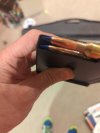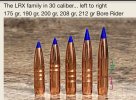No flex at all, what the grooves in the bullet sidewall do is remove bearing surface(the sides of the bullet that contact the rifling) and that lesser amount of contact/friction decreases the pressure because the bullet is easier to push out of the barrel. The bands can allow a heavier bullet to be shot faster than a lighter bullet that does not have the reliefs cut giving it more contact/friction with the barrel.
Notice the contact points from the rifling on this bullet and see how they only contact the high spots.... the groove reduce contact with the barrel = lower pressure which is longer barrel life. Or you can have equal barrel life but be able to shoot the bullets faster.
View attachment 432482


